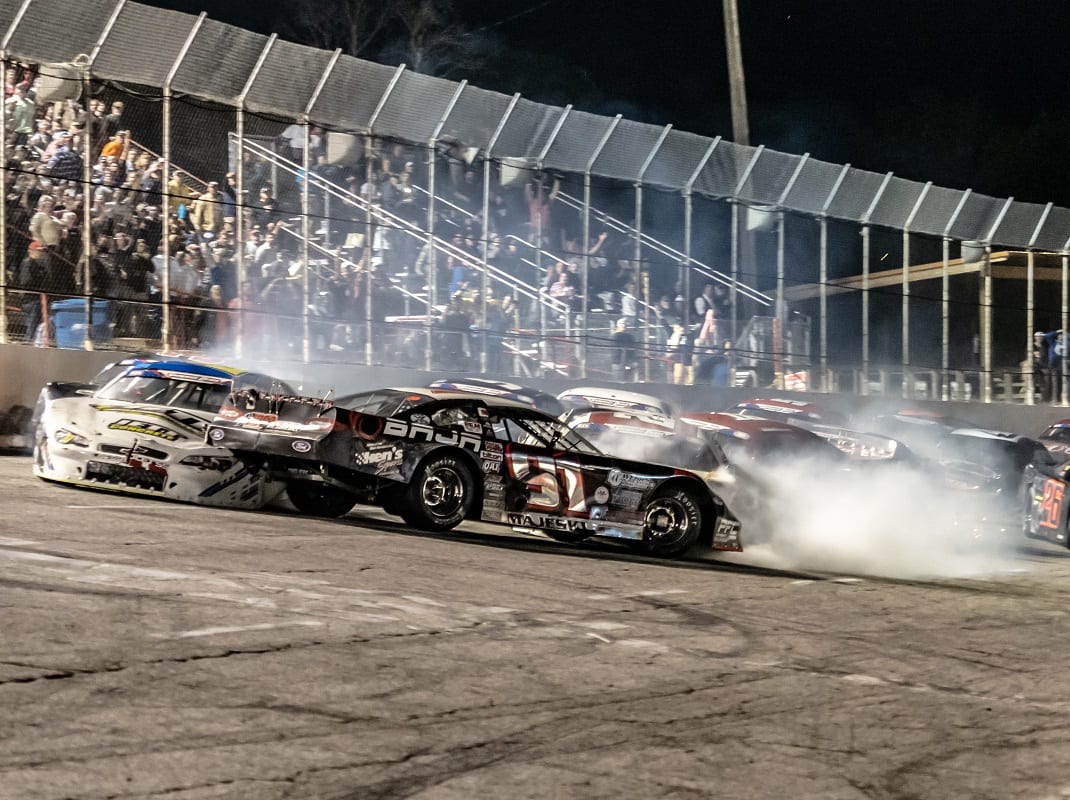PENSACOLA, Fla. – Ty Majeski had the car to beat in the closing stages of Monday night’s 52nd annual Snowball Derby, but a late restart in double overtime ripped the Tom Dawson Trophy from his fingers.
Majeski, who headed the field twice for 139 laps, was the leader coming to what would have been the white flag if not for a crash between Cole Butcher, Travis Braden and Jeremy Doss in the second corner.
Butcher got into Braden and looped Braden’s No. 26 around, setting in motion the chain of events that ultimately took Majeski’s dominance and ended it in one fell swoop.
The Seymour, Wis., native didn’t get as strong of a restart on lap 318 as he had the rest of the night, which left the inside lane nowhere to go behind him.
Third-running Casey Roderick got into the back of Majeski’s No. 91 and lifted the rear tires off the ground, sending Majeski spinning in a cloud of smoke after he bounced off of Nasse’s No. 51.
At that point, all hell broke loose.
Majeski’s car, sitting sideways as it was shoved down the frontstretch, was tagged by numerous cars from throughout the field. Those involved or eliminated from the race in the accident included Jeff Choquette, Roderick, polesitter Derek Thorn, Gio Bromante, John DeAngelis, Derek Kraus, Matt Craig, Michael Atwell, Brad May, Cole Moore and Chandler Smith.
A multi-time champion of the ARCA Midwest Tour, Majeski’s restarts were a topic of discussion in race control during the night, and the driver didn’t hesitate to call out the officiating crew for, in his eyes, generating the storm that led to the crash.
“They were just complaining about my restarts the entire race,” Majeski told SPEED SPORT. “The way they wanted to do it versus the way that turn three here at Pensacola is shaped … it just doesn’t work. I don’t know why they can’t just do NASCAR-style starts, with firing the box where the leader fires first and whatever happens after that goes. That’s pretty black and white in my opinion, but they wanted a gradual pickup.

“If you gradually pick it up in three and four here getting into three, then you can’t keep it off the bottom off four. They didn’t like my second to last restart, so on the last one I just did a slow gradual … and at that point you’re a sitting duck because the guy on the outside knows when you’re gonna go,” Majeski added. “The guy in third knows when you’re going to go. And when I went, the 22 just was in my back bumper cover and the rear wheel were lifted off the ground. I couldn’t go.
“I don’t understand why we need a slow-moving start for the Derby. It’s just ridiculous, really.”
Roderick admitted after the crash he just had nowhere else to go once he got into Majeski’s bumper.
“Majeski, the last few restarts, I wouldn’t say he was playing games, but race control was on him for being too slow,” Roderick said. “We picked it up the last couple. He jumped sideways when he got on the gas and got into (Nasse), and I was right there with him.
“I was looking to get under him if he slipped up any more, and he got sideways when he hit the 51.”
Race director Nicholas Rogers, in his first year at the helm of the Snowball Derby, met with the media following the race to discuss the restart procedures after first discussing things with Majeski.
“The procedure was to start increasing speed in turn three, slowly and steadily increasing all the way through until you come off of (turn) four to the start-finish line,” Rogers said. “You cannot pass until the start-finish line. Those are the rules as they are done by multiple series — CRA and the SRL (Southwest Tour) series out west. I’m pretty sure the ARCA Midwest Tour does this. I know tracks up north use that same procedure. We used this at New Smyrna during Speedweeks too.
“We’d never really had an issue with it. It keeps from people playing jackrabbit coming into the box and touching the brakes, where the first five, six, seven rows have zero issues, but the accordion backs up the rear and it tears a lot of race cars up,” Rogers continued. “This has kept that from happening and we’ve tore up a lot less race cars with these procedures. Going forward, you know, I’m not going to say there won’t be changes to minor issues or tweaks here and there.”
Majeski said he’ll be back in 2020 to the Derby, but still doesn’t agree with Rogers’ assessment.
“I came down here hoping to understand better what they wanted,” he said. “Personally, I hope they change it for next year, because the leader is just a sitting duck the way they want to do it here. … The way they want to restart the race just doesn’t work for the way this track is built. I hope they rethink their decision to change the rules, because it has never been like that in years past. This was new for this year.
“I just wanted some clarity on what they wanted, what I could have done differently and hopefully I can … not persuade them, but at least put it in their minds and let them think about it for next year. Because the way it is now and the way it went tonight … these are the best short track drivers in the country, and for the leader to not have some sort of an advantage (on the restart) is just ridiculous in my opinion.”
